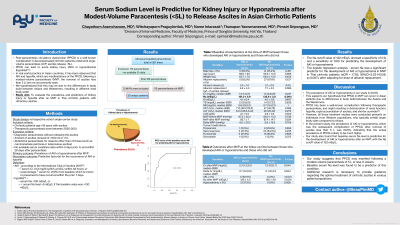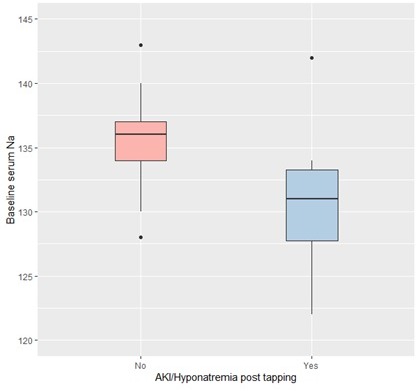Sunday Poster Session
Category: Liver
P0924 - Serum Sodium Level Is Predictive for Kidney Injury or Hyponatremia After Modest-Volume Paracentesis (<5L) to Release Ascites in Asian Cirrhotic Patients
Sunday, October 22, 2023
3:30 PM - 7:00 PM PT
Location: Exhibit Hall

Has Audio
- CA
Chayathorn Aramcharoen, MD
Prince of Songkla University
Hat Yai, Songkhla, Thailand
Presenting Author(s)
Chayathorn Aramcharoen, MD, Pimsiri Sripongpun, MD, Witchayaporn Praguylertluk, MD, Thanapon Yaowmaneerat, MD, Naree Intarasak, RN
Prince of Songkla University, Hat Yai, Songkhla, Thailand
Introduction: Post-paracentesis circulatory dysfunction (PPCD) is a well-known complication in decompensated cirrhotic patients who undergo large-volume paracentesis (LVP; ascites release >5L), PPCD can lead to acute kidney injury (AKI) or hyponatremia (hypoNa). Due to the smaller body build of Asian patients, we hypothesized that removal of < 5L ascites (modest-volume paracentesis; MVP) may also lead to PPCD. We aimed to investigate whether MVP could lead to AKI or hypoNa in Asian patients and determine factors associated with such conditions.
Methods: We conducted a retrospective study of cirrhotic patients who underwent abdominal paracentesis at GI unit of a tertiary care hospital in Thailand. We included all abdominal paracenteses performed between 2020-2021. Exclusion criteria were LVP and those without available serum creatinine (Cr) data before and after the procedures. AKI was defined as the International Ascites Club criteria 2015, and hypoNa was defined as serum Na level < 130 mEq/L after paracentesis or a drop of >5 mEq/L if Na was < 130 mEq/L before the paracentesis.
Results: There were 301 paracenteses performed during the study period. Of those, 39 distinct patients underwent 73 MVPs. The data of the first time MVP in each patient were used for the analysis. Eight patients (20.5%) developed AKI or hypoNa within 7-28 days after MVP. There was no significant difference between the patients who developed AKI or hypoNa and who did not in terms of demographic characteristics, amount of ascites released, amount of albumin infusion, baseline Cr, K, liver chemistry test, and blood pressure before and after paracentesis. Interestingly, baseline serum Na level were significantly lower in patients who developed AKI or hypoNa compared to who did not (131.0±5.9 vs 135.6 ± 3.0 mEq/L, p=0.004). The Na cutoff value of 132 mEq/L showed a specificity of 0.9, and a sensitivity of 0.63 for predicting the development of AKI or hypoNa (AUC 0.81). A logistic regression analysis confirmed that serum Na was a significant predictor for the development of AKI or hypoNa after MVP in Asian patients (aOR = 17.92, 95%CI=2.23-143.56, p=0.007), after adjusting for the dose of albumin replacement.
Discussion: PPCD resulting in AKI or hypoNa did occur after MVPs in Thai cirrhotic patients. Baseline serum Na < 132 mEq/L is independently associated with the development of AKI or hypoNa after the procedure. These results might aid the decision of albumin replacement in Asian cirrhotic patients undergoing MVPs in the future.

Disclosures:
Chayathorn Aramcharoen, MD, Pimsiri Sripongpun, MD, Witchayaporn Praguylertluk, MD, Thanapon Yaowmaneerat, MD, Naree Intarasak, RN. P0924 - Serum Sodium Level Is Predictive for Kidney Injury or Hyponatremia After Modest-Volume Paracentesis (<5L) to Release Ascites in Asian Cirrhotic Patients, ACG 2023 Annual Scientific Meeting Abstracts. Vancouver, BC, Canada: American College of Gastroenterology.
Prince of Songkla University, Hat Yai, Songkhla, Thailand
Introduction: Post-paracentesis circulatory dysfunction (PPCD) is a well-known complication in decompensated cirrhotic patients who undergo large-volume paracentesis (LVP; ascites release >5L), PPCD can lead to acute kidney injury (AKI) or hyponatremia (hypoNa). Due to the smaller body build of Asian patients, we hypothesized that removal of < 5L ascites (modest-volume paracentesis; MVP) may also lead to PPCD. We aimed to investigate whether MVP could lead to AKI or hypoNa in Asian patients and determine factors associated with such conditions.
Methods: We conducted a retrospective study of cirrhotic patients who underwent abdominal paracentesis at GI unit of a tertiary care hospital in Thailand. We included all abdominal paracenteses performed between 2020-2021. Exclusion criteria were LVP and those without available serum creatinine (Cr) data before and after the procedures. AKI was defined as the International Ascites Club criteria 2015, and hypoNa was defined as serum Na level < 130 mEq/L after paracentesis or a drop of >5 mEq/L if Na was < 130 mEq/L before the paracentesis.
Results: There were 301 paracenteses performed during the study period. Of those, 39 distinct patients underwent 73 MVPs. The data of the first time MVP in each patient were used for the analysis. Eight patients (20.5%) developed AKI or hypoNa within 7-28 days after MVP. There was no significant difference between the patients who developed AKI or hypoNa and who did not in terms of demographic characteristics, amount of ascites released, amount of albumin infusion, baseline Cr, K, liver chemistry test, and blood pressure before and after paracentesis. Interestingly, baseline serum Na level were significantly lower in patients who developed AKI or hypoNa compared to who did not (131.0±5.9 vs 135.6 ± 3.0 mEq/L, p=0.004). The Na cutoff value of 132 mEq/L showed a specificity of 0.9, and a sensitivity of 0.63 for predicting the development of AKI or hypoNa (AUC 0.81). A logistic regression analysis confirmed that serum Na was a significant predictor for the development of AKI or hypoNa after MVP in Asian patients (aOR = 17.92, 95%CI=2.23-143.56, p=0.007), after adjusting for the dose of albumin replacement.
Discussion: PPCD resulting in AKI or hypoNa did occur after MVPs in Thai cirrhotic patients. Baseline serum Na < 132 mEq/L is independently associated with the development of AKI or hypoNa after the procedure. These results might aid the decision of albumin replacement in Asian cirrhotic patients undergoing MVPs in the future.

Figure: Baseline serum Na levels in patients who developed AKI or HypoNa after modest-volume paracentesis.
Disclosures:
Chayathorn Aramcharoen indicated no relevant financial relationships.
Pimsiri Sripongpun indicated no relevant financial relationships.
Witchayaporn Praguylertluk indicated no relevant financial relationships.
Thanapon Yaowmaneerat indicated no relevant financial relationships.
Naree Intarasak indicated no relevant financial relationships.
Chayathorn Aramcharoen, MD, Pimsiri Sripongpun, MD, Witchayaporn Praguylertluk, MD, Thanapon Yaowmaneerat, MD, Naree Intarasak, RN. P0924 - Serum Sodium Level Is Predictive for Kidney Injury or Hyponatremia After Modest-Volume Paracentesis (<5L) to Release Ascites in Asian Cirrhotic Patients, ACG 2023 Annual Scientific Meeting Abstracts. Vancouver, BC, Canada: American College of Gastroenterology.
